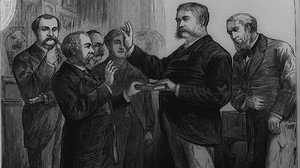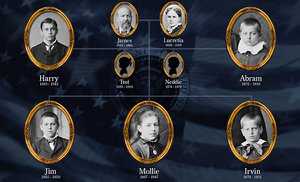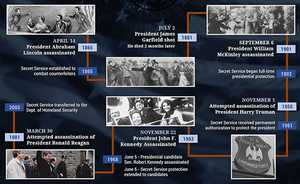Who's Who

Lucretia Rudolph Garfield
Born to Zeb and Arabella Rudolph in 1832, Lucretia, or "Crete" as she was known, enrolled in the first class at Western Reserve Eclectic Institute (now Hiram College), an institution her father helped found. An avid intellectual, Lucretia edited the school magazine, began a literary society, and staged debates, arguing that women, like men, should be allowed to debate publicly.
While at the Institute, Lucretia attracted the attention of James Abram Garfield, and the two began a long correspondence while he attended Williams College in Massachusetts. She became a teacher upon graduation, a career she gave up when she and James were married in 1858. Crete worried even before their wedding that James was marrying her out of a sense of obligation, writing him, "There are hours when my heart almost breaks with the cruel thought that our marriage is based upon the cold stern word duty." It is possible he originally did, as he admitted that the marriage lacked the passion that he had hoped for in a relationship: "there is no delirium of passion nor overwhelming power of feeling that draws me to her irresistibly." Nevertheless, James and Lucretia had seven children together, though their first and last children both died as toddlers.
When James had an affair with a woman in New York in 1864, Crete's reaction and the strength she showed in the face of his infidelity made him realize that the part of her he had seen as cold and unloving was instead a source of quiet strength and independence. As they navigated their post-affair relationship, Garfield fell more in love with his wife. By the time he was elected president, his passion for her matched the intellectual attraction they had always shared. When she fell ill with malaria two months after they moved to the White House in 1881, he stayed by her side, refusing to attend to business matters, until she showed signs of recovery.
Crete was spending time on the New Jersey shore to recover fully from the malaria when Garfield was shot on July 2, 1881. She arrived at the White House that evening just before his doctors sent out a bulletin pronouncing the president as good as dead. With her by his side, however, he began to strengthen, and the doctors soon published an updated bulletin reporting on his much improved condition. In the days and weeks that followed, the First Lady exhibited fortitude, faith and resilience, traits that comforted and impressed the American public. After James's death in September, Crete received many letters from a grieving American public as well as financial support in the form of a fund set up for her and her children. She returned to the family farm in Ohio intent to preserve her husband's papers and legacy. Her project, which began with the deposit of all the letters exchanged between her and James and was financed with some of the money from the memorial fund, would become the nation's first presidential library. Crete lived to see her five children prosper, and she died in 1918 at age 85.

Charles Guiteau
Born in 1841 in Freeport, Illinois, Charles Guiteau was seven years old when his mother, who suffered from psychosis, died. Raised by his sister and later his stepmother, Guiteau drifted from obsession to obsession as an adult. While in college briefly in Ann Arbor, Michigan, he discovered the writings of John Noyes, founder of the Oneida Community, a utopian community in upstate New York that practiced what Guiteau referred to as "Biblical communism." Guiteau joined the Oneida Community, living and working there for six years before moving to New York City, where he harbored a growing resentment toward the Oneida Community. Guiteau went so far as to hire a lawyer to sue John Noyes for compensation for the six years he had worked in the community, but Noyes fought back. Guiteau's lawyer dropped the case, but Guiteau continued sending threatening letters blaming the community for his personal troubles, including unemployment. At one point, Noyes wrote Guiteau's father, "I prayed for him [Charles] last night as sincerely as I ever prayed for my own son, that is now in a Lunatic Asylum."
Guiteau eventually returned to Illinois, where he maintained a brief and reportedly abusive marriage before becoming obsessed with theology. After a period of time he spent traveling and speaking as a "lawyer and theologian," Guiteau turned his eye to politics. He threw himself into campaigning for former president Ulysses S. Grant, the Stalwart-backed candidate for Republican nominee in the 1880 election. When Garfield became the nominee rather than Grant, Guiteau, wrote one biographer, "simply scratched Grant's name from his speech and substituted Garfield's."
En route to New York City in August 1880, Guiteau survived the Stonington-Narragansett steamship collision and disembarked believing that God had spared him for a great purpose. While in New York, Guiteau spent time at the Republican Party headquarters, though he never worked there. He also wrote a speech that he had printed and distributed himself. When Garfield won the election in November, Guiteau was convinced that his speech played a major role in the election and began to petition Garfield for a diplomatic post that he believed Garfield owed him. When Garfield and later Secretary of State James A. Blaine rebuffed him, Guiteau claimed to have heard God telling him to remove Garfield.
On July 2, 1881, Guiteau shot President Garfield in a train station. He wrote an "Address to the American People" in which he provided justification for the political murder, leaving the document for police and newspapermen. After killing Garfield, Guiteau believed that Chester Arthur would become president, and Guiteau himself would be pardoned and released from jail and made consul to Paris. Instead, in the wake of Garfield's death in September, Guiteau was put on trial and found guilty of murder. He was sentenced to death by hanging and executed on June 30, 1882.

Chester Alan Arthur
A lawyer and loyal supporter of the Stalwart faction of the Republican Party, Chester Alan Arthur had never run for political office when he was chosen as James Garfield's vice presidential running mate in 1880. Born in Vermont, Arthur worked as a teacher and later a lawyer in New York City before being appointed Collector of the Port of New York in 1871. Arthur's mentor, Roscoe Conkling, bequeathed the post -- the highest paying federal job in the United States -- upon Arthur as a reward for his loyalty to the Stalwarts. When Rutherford B. Hayes ascended the presidency in 1876, he attempted to wrest control over the appointment of the Collector of the Port of New York from Roscoe Conkling by removing Arthur from the post. Conkling waged war on Hayes, challenging the President for the rest of his term. At the Republican nominating convention in 1880, James Garfield beat the Stalwart-backed nominee, former President Ulysses S. Grant, for the presidential nomination. To soothe the anger of their faction of the party, Stalwarts were given the opportunity to name the vice presidential nominee. Their choice was Chester A. Arthur, an indication that the Stalwarts intended to continue Conkling's influence in the White House. Indeed, a repentant Arthur later lamented that in his early days as Vice President, he had been insubordinate to President Garfield.
When Charles Guiteau shot President Garfield, Guiteau shouted, "Arthur will be president," igniting suspicion that Arthur and Conkling had some hand in the attempt on Garfield's life. But when Garfield died and Arthur became president, Arthur acted very differently than many had feared, or in Conkling's case, hoped. In his first address as president, Arthur said, "All the noble aspirations of my lamented predecessor…will be garnered in the hearts of the people; and it will be my earnest endeavor to profit, and to see that the nation shall profit, by his example and experience."
Instead of being Conkling's puppet in the White House, Arthur asserted himself as his own man, and in a complete reversal, championed civil service reform, anathema to Stalwart loyalists. Publisher Alexander K. McClure later recalled, "No man ever entered the Presidency so profoundly and widely distrusted, and no one ever retired ... more generally respected." President Arthur served one term and was not nominated as the Republican presidential candidate in the 1884 election. He died in 1886 at age 57.

Dr. Willard Bliss
Dr. D. Willard Bliss became the lead physician in charge of President Garfield's care shortly after the President was shot on July 2, 1881. Bliss and Garfield, acquaintances since Garfield's childhood in Ohio, had crossed paths a number of times before Bliss was summoned to the Baltimore and Potomac train station that morning. Years earlier, Dr. Bliss, expelled from the District of Columbia Medical Society for his interest in homeopathy and his refusal to support the society's policy of excluding black doctors, had gained the support of Congressman Garfield, who wrote Bliss a letter of support after his expulsion. Bliss later apologized to the society and regained his reputation as an accomplished surgeon, but the experience of being humiliated for embracing homeopathy, a fairly new medical field, made Bliss hesitant to embrace another new medical field, anti-septic medicine, when it emerged in the 1870s.
Bliss, like many American physicians, did not believe there was a definitive link between unclean equipment and infection, and rejected the methods advocated by Joseph Lister to sterilize hands and equipment. Thus, after Garfield was shot, multiple doctors with unwashed hands and tools probed the president's bullet wound as he lay on the dirty floor of the train station. Dr. Bliss's probing was the most aggressive. Dr. Charles Purvis, a doctor present at the train station who would that day become the first black physician to treat a U.S. president, was so horrified by the probing that he asked Dr. Bliss to end his examination despite the social taboo of a black doctor challenging a white doctor. Bliss ignored Purvis's request, and in the days that followed at the White House, Bliss probed the wound a number of times, desperately hoping to find the bullet, never washing hands, and never cleaning the wound itself. Bliss considered the pus that developed to be a sign of healing rather than a sign of serious infection. After the president seemed to be recovering, only to develop a fever and chills before weakening again, Bliss became desperate, employing increasingly radical treatments in an attempt to save the president.
After Garfield's death, the doctors present at the autopsy, including Dr. Bliss, were shocked at the amount of septic infection evident in the President's body. Not only had Dr. Bliss been roughly a foot off in his estimate of where the bullet had lodged, but also, the bullet itself, safely encased in the abdomen, would likely not have killed the president. Instead, it was the septic infection from the rigorous and unsanitary course of treatment Bliss prescribed that led to the president's death. The autopsy became an indictment of Dr. Bliss, and Charles Guiteau even argued at his trial that it was the doctors, not his bullet, that killed the president. Dr. Bliss would never recover his reputation, and he died of a stroke seven years later.

Roscoe Conkling
The son of a Congressman, New York Senator Roscoe Conkling had risen to become one of the most powerful men in the Republican Party. At turns admired and feared by party leaders, Conkling cut an impressive figure, his good looks and physicality matched by his reputation as a charismatic speaker. As leader of the faction of the Republican Party known as the "Stalwarts," Conkling worked to secure the rights of freed slaves and helped draft the Fourteenth Amendment. He also passionately supported maintenance of the spoils system, the political machination that rewarded those loyal to the party with high-paying and influential jobs. The source of Conkling's personal power, the spoils system gave him, as a senator of New York, the ability to control the New York Customs House, which brought in more money to the United States than all other American ports combined, by giving him discretion to appoint the Customs House chairman. When President Rutherford B. Hayes tried to assert his presidential power and reform the spoils system in 1878 by removing Conkling's appointment to the Customs House, his friend Chester Arthur, Conkling attacked Hayes with a vengeance, ultimately winning the power struggle.
President Garfield, also intent on reforming civil service by dismantling the spoils system, directly challenged Conkling within weeks of taking office in 1881, removing Conkling's Customs House chairman and appointing his own choice. In a bitter struggle with Garfield, Conkling resigned his senate seat in protest, believing that he would be reinstated to the seat immediately and unanimously by the New York state legislature. He expected his swift reinstatement to be a vivid display of his power to set him up to challenge Garfield as he had President Hayes. The move was a miscalculation on Conkling's part -- a step too far for legislators who had grown tired of Conkling's ruthless wielding of power. Conkling was not reinstated quickly or even at all, and President Garfield emerged as the clear leader of the Republican Party. When Garfield was shot a month later, suspicion quickly fell on Conkling and his most loyal supporter, Vice President Chester A. Arthur.
Though Conkling was never connected to Guiteau's plot to kill the president, many believed that Conkling's divisive rhetoric and the corruption inherent in the spoils system itself were to blame for the political environment that bred Guiteau's plan. Defeated by Garfield and then spurned by his old friend Chester Arthur once Arthur became president, Conkling virtually disappeared from political life and died in 1888.

James G. Blaine
James G. Blaine of Maine and James Garfield of Ohio entered the U.S. House of Representatives together in 1863. Colleagues and friends, both men had risen to the height of power within the Republican Party by 1880. Blaine, elected Speaker of the House in 1868, held that post for six years before being elected to the Senate in 1876. As leader of the faction of the Republican Party known as "Half-Breeds," Blaine formed a coalition of moderates who backed him as nominee for president in the 1880 election. But there was bad blood between Senator Blaine and Senator Conkling that dated back to a public feud on the House floor in which Blaine dramatically derided Conkling's arrogance: "The contempt of that large-minded gentleman is so wilting; his haughty disdain, his grandiloquent swell, his majestic, supereminent, over-powering, turkey-gobbler strut has been so crushing to myself and all members of this House that I know it was an act of the greatest temerity for me to venture upon a controversy with him." Neither man had forgotten the feud, adding a personal vitriol to the divisions within the Republican Party.
While Blaine led the Half-Breed faction of the party, Senator Conkling led the Stalwarts, backing former President Ulysses S. Grant in the contest to nominate the Republican candidate for president in 1880. Though each candidate arrived at the Republican Convention with 300 of 379 delegates needed to win the Party's nomination, neither man could collect the other 79 votes. When Garfield prevailed at the convention, James Blaine's wife Harriet was one of the first to send a telegram congratulating him on the nomination. As Garfield prepared to fill his cabinet after winning the general election, he summoned James Blaine and offered him Secretary of State or Secretary of the Treasury. Blaine chose Secretary of State. On July 3, 1881, Blaine escorted Garfield to the Baltimore and Potomac train station and was walking beside the President when he was shot by Charles Guiteau.
In 1884, Blaine became the Republican nominee for president, and he narrowly lost the general election to Democrat Grover Cleveland. Blaine served as Secretary of State under President Benjamin Harrison from 1889 until his resignation in June of 1892. He died soon after, in January 1893, days before what would have been his 63rd birthday.







